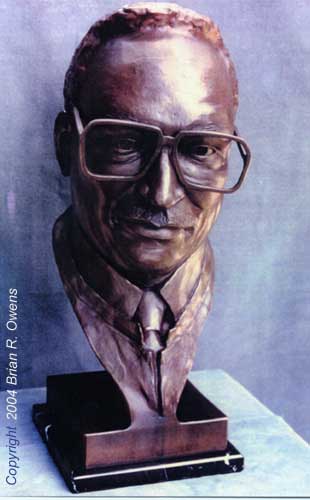 |
|
| Reverend Herman E. Brandon
Cast bronze portrait, unique, height: 22", including base |
|
|
This over-life size bronze portrait of the late Reverend Herman E. Brandon, Sr.,
was commissioned by Tangelo Baptist Church in Orlando, Florida where he was paster for many years. It was completed over a period of several months as Owens
worked from various photographs with the assistance of the Reverend's son and a close friend. The finished bronze portrait
was hidden until an emotional unveiling ceremony. During a recent interview Owens said "The highest goal in portraiture is to reveal
something of the spirit and character of the subject". THE ALLURE OF THE BRONZE PORTRAIT There is no known lifespan for a cast bronze portrait. It is a timeless medium. A bronze portrait, properly maintained, will last until it is intentionally destroyed. Most historians suspect that the process of bronze casting was created about 1800 years BC by Mediterranean cultures or perhaps China. Sophisticated copper artwork has been traced back 5000 years B.C. but the deliberate mixing of two or more different metals to create a new metal with properties different from its constituent parts is what bronze is about. It's an alloy. To create something by carving it out of a block is a straightforward and intuitive method of fabrication. Cavemen did that. But to create an alloy that does not exist in nature and then cast the molten metal into a shape - accurately - required that men think differently about the world they lived in. The bronze age was a vitally important step in the accent of mankind and the bronze portrait is symbolic of this. The Egyptians, the Chinese, the Greeks and the Indians all advanced the technology in their tireless pursuit of more impressive artwork and more durable weapons. During the Renaissance, great sculptors combined forces with great foundries and achieved a sort of immortality through their art. It is against this backdrop of history that the bronze portrait is judged. An excellent portrait completed in any medium is worthy of praise. But to complete that same portrait in bronze is a larger challenge requiring a wider mastery of methods and materials. The level of difficulty is another reason the bronze portrait is so highly regarded. PRACTICAL CONSIDERATIONS A bronze portrait can be tastefully done of anyone at any age. Because of the cost, most bronze portrait commissions are paid for by groups of people such as churches, museums and associations. Fundraising is a bit easier when the subject is deceased, therefore most people associate the bronze portrait with the very old or deceased, improperly so. Most bronze portraits are "life-size". In other words, it is physically the same size as the head of the subject. If the bronze portrait is to be located out of doors, then its a good idea to sculpt it "over life-size" so that it does not look small in comparison to everything else outside. If your budget will not allow for a bronze portrait you have other options. You may have your portrait sculpted out of hardened clay or ultra-hard plaster. You can always use it to cast a bronze portrait in the future. The process will reproduce the surface of your clay or plaster leaving the original intact. Once the surface of the bronze portrait is "chased" (perfected with hand-tools) and sanded it looks like a shiny new penny - far too bright and reflective. Left alone, the shiney bronze portrait would naturally darken over many years due to oxidation. But why wait? The bronze portrait is usually given a chemical patina to achieve a deep rich color. |
|

